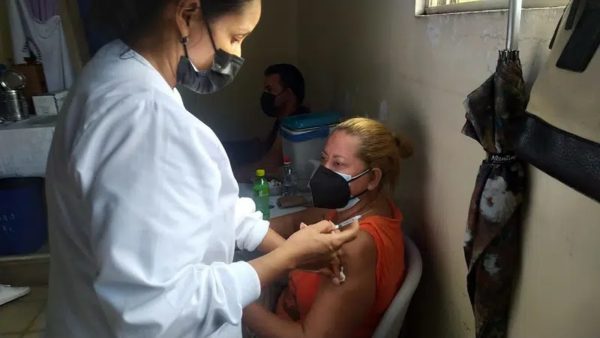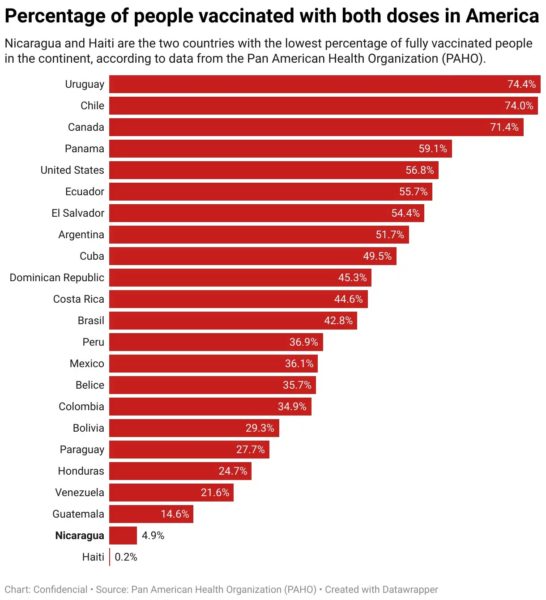Why Nicaragua Has So Few Vaccinated
at the tail end for vaccinations in the Americas

A total of 5.3 million doses would be needed to vaccinate 40% of Nicaragua’s eligible population. At present, less than 5% of Nicaraguans are fully vaccinated.
HAVANA TIMES – The two poorest countries on the continent, Haiti and Nicaragua, haven’t managed to vaccinate even 10% of their population against COVID-19 in the first nine months of 2021. Both nations are in last place in the Americas, with less than 5% of their people having received the two doses, according to the official data published by the Pan-American Health Organization (PAHO).
Haiti, began offering COVID-19 vaccines in July, but only managed to complete the two-dose series in October, with 25,579 people receiving it. Meanwhile, Nicaragua began the inoculation campaign in March, at which point they were able to fully vaccinate 328,206 Nicaraguans, representing 4.9% of the population.
These percentages are far from the new goal proposed by the Covax Mechanism, a worldwide vaccination initiative sponsored by the World Health Association. The Covax program aims to vaccinate 40% of the population of all the countries in the region before year’s end. In order to reach this proportion, Nicaragua would need at least 5.3 million vaccine doses. Up until now, they’ve only recently received a total of 2.3 million doses, of which they’ve used 999,990: 671,784 first doses have been given and 328,206 second shots.
“It’s encouraging to see that 26 countries and territories in the Americas have now immunized 40% or more of their population. However, that’s not the reality everywhere. Six countries in our region – Jamaica, Santa Lucia, San Vicente and the Grenadines, Haiti, Guatemala and Nicaragua – have yet to vaccinate 20% of the population,” stated Carissa Etienne, PAHO director.
The vaccination process has advanced very slowly in Nicaragua; it’s also been scattered and politically centralized. Below are some of the key reasons the country continues to lag behind other nations.

Lack of doses
The scarcity of the vaccine caused delays in the first vaccination clinics. The first doses applied were principally those donated by Russia, India and the Covax mechanism.
The latter promised to send enough doses to Nicaragua to immunize 20% of the population, but in the first semester of this year only managed to send 135,000 doses of the “Covishield” vaccine. The delay was caused when India, the site of the factories that produce the Covishield vaccines, was engulfed by its own public health crisis and opted to suspend exports of the vaccines in order to use them domestically.
As a result, Nicaraguan only had 531,000 doses available for the first vaccination clinics held between March and June of 2021. They offered these vaccines to those older than 55, people with chronic kidney failure, and a part of the frontline workers in the Health Ministry, the Army, the Immigration agency, the Police and the Customs Office.
Of the half-million vaccines that they used during this period, 190,000 doses came from an initial purchase of the Russian Sputnik V vaccine that the government negotiated in May 2021.
Purchases limited to government allies
According to the “COVID-19 Vaccine Project”, a document that the Ortega government published last January, this year they projected acquiring 7.4 million doses of three types of vaccines: the Sputnik V, the Moderna vaccine and AstraZeneca. These doses would be used to immunize 3.7 million people, equivalent to 55% of the population.
Since the end of April 2021, Nicaragua has received a US $100-million-dollar loan from the Central American Economic Integration bank, as well as creating their own US $19.8 million dollar fund. The National Assembly, controlled by the government party, recently approved the latter.
Nonetheless, nine months later, only the acquisition of 1.9 million doses of the Russian Sputnik V vaccine and 800,000 doses of Sputnik Light is known. Of this quantity, only a third of the promised doses have arrived in the country six months later.
Similarly, seven million Cuban vaccines have been acquired: Abdala, Soberana 02, and Soberana Plus. These vaccines have not yet been approved by the international health organizations, and it’s not clear whether they were purchased or donated, although last July, Cuba informed that it was negotiating sales to Nicaragua.
There’s no public information available regarding whether Nicaragua has attempted negotiating purchases anywhere beyond Russa and Cuba. It’s equally unknown why the Ortega government created additional funds for vaccine purchases, when they already had US $100 million for this purpose.
According to Ortega, the scarcity of vaccines is due to hoarding on the part of the wealthy countries. “Not even if we had the money would we have the capability of competing with the countries that have more money and can pay more and better for those vaccines,” Ortega has declared.
Even so, the rest of the countries in the region have managed to acquire vaccine supplies. El Salvador has already applied over 7.8 million doses; Guatemala over 7.3 million; and Honduras over 5.8 million. Meanwhile, Nicaragua is barely about to complete the first million vaccinations.
Donations have sped up the vaccination campaigns
The COVID-19 vaccine campaigns finally began moving in September, after Nicaragua received over 1.3 million doses from the Covax Mechanism. Following receipt of these donations, the Health Ministry was finally able to begin including all those over 30 in the prioritized group.
This was the largest COVID vaccine campaign that the country has carried out to date, since it included different age groups. This caused a virtual stampede, with people lining up a day before the doses were to be applied, in queues that stretched out for kilometers. In some of the departments, people stood in the rain in the lines, waiting to receive their vaccine.
Details of the advance of the vaccination process in the country are still unknown. The authorities haven’t reported whether all of the population with chronic health conditions are vaccinated, nor the breakout of vaccinations by age groups.
According to Ortega, the immunization plan being implemented in the country is focused on the population over 30. It’s hoped that by year’s end they’ll be able to immunize 2.8 million people. That, however, represents less than half of the original promise. However, Ortega also announced they plan to vaccinate 2.1 million teens and children over 2 years old.






Comments are closed.